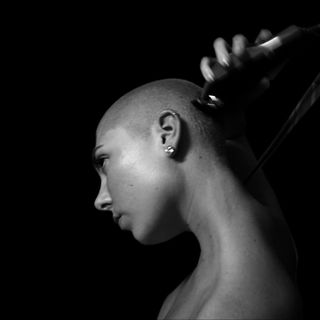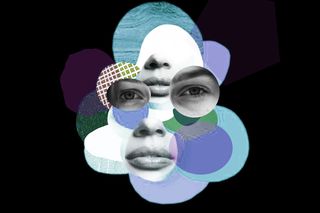
Body Positivity Is Excluding People; What If We Got Rid of Beauty Instead?
If we destroy the concept of human beauty, then we won’t have to cram everything into its definition.

Whether we realize it or not, most of our evaluations about other people begin and end with how they look. As a society, we set a lot of store by a person’s physical appearance, from their hair, skin, body type and weight, to how they dress, talk or conduct themselves. We take physical beauty in humans for granted, even though society’s unfair value of it perpetuates shame and a correcting mindset. So much do we value beauty, and the privileges it affords, even emerging movements that seek to democratize physical appearance can’t shake the hierarchy they aim to upend. From body positivity (which seeks to inculcate positive feelings in all humans regarding how they look), to body neutrality (which advocates for people to be okay with how they look, even if they can’t yet make positive associations with their bodies) — all rest on the premise that feeling beautiful is still a valuable goal. But beauty is an oppressive concept where there are never any winners.
So, what if we got rid of it?
Imagine a post-beauty world: It’s where we no longer work to include everybody in the exclusive club that is beauty, because let’s face it — there are never going to be enough chairs. Let the club go defunct instead. In a post-beauty world, we don’t work to condemn physical beauty, nor do we strive to include more and more types of it under its narrow definition. We simply — don’t notice it.
Right now, we’re picking and choosing what physical appearances we want to accept — Fat? Yes, body positivity all day every day. Dark-skin? Sure, let’s wage campaigns against the stigma. Acne? Nope, not gotten that far yet, let’s peddle some skin-correcting beauty products. Scars? Hell no, cosmetic surgery, please; it’s unnatural. Baldness? Nuh-uh, cover that up. Nipples? Oof, big no; let’s spout some pseudo-science gibberish the need for bras and the danger of saggy boobs and hide the nipple at all costs. As long as being ‘beautiful’ remains a benchmark that everyone wishes to achieve, there will remain a hierarchy that separates the ‘beautiful’ from the ‘ugly,’ and the hierarchy will always be unfair, baseless, and completely unnecessary.
But — if we stop trying to fit things under beauty, stop making or considering new things beautiful, and instead just stop categorizing things as such, then there is no umbrella, no club, no overarching definition that needs to be expanded, nor people who feel left out.
Related on The Swaddle:
Toxic Beauty Rituals Still Plague Women in a Society Obsessed With Skin Care
It’s a Utopian idea, yes — but one that is necessary to entertain. When we reward beauty, we automatically penalize anyone who doesn’t fit the standards. And beauty gets plenty of rewards. A beautiful person is more likely to be thought of as happy, intelligent, popular and fun — and that translates to ‘attractive’ people getting more perks in society, from being considered more qualified for jobs (even if they aren’t, actually), to getting more votes in elections.
The idea of a rigid masculine and feminine sort of beauty — broad jaws in men, and delicate features in women, for example — is also encouraged and celebrated in popular culture, which makes gender expression for those who don’t fit into the male-female binary, or even the traditional expressions of the two genders difficult. As long as there’s a standard to adhere to, all those who flout it — effeminate men, some trans and non-binary folks, etc. — will keep doing the mental labor to convince the world of their physical beauty, successfully so perhaps. At best, the beauty umbrella might get fragmented into smaller umbrellas, but those who express their gender identities in physical ways the world has not yet learned to celebrate will still be left out, just as anybody whose physical appearance the world has not yet deemed worthy of inclusion.
Interestingly, this strict adherence to gendered beauty standards is a Western, urban trope. Researchers from Brunel University in London looked at remote communities in Asia, Africa, South America, and Russia and found women were more attracted to ‘feminine’ looking men, a trend that was reversed in urbanized populations that were visually exposed to more media. But the pervasiveness of media, and the increasing interconnectedness of the world makes it difficult to escape the widespread support of beauty standards, whatever they are or become. American researchers from Johns Hopkins University in Baltimore asked dating site users to rate people on the basis of their looks. Some of the users were also shown the average score for the person whom they were rating. As soon as users found out which person had a higher average score, they started giving them a high score too, and soon, everybody started rating people along similar lines. All of this was anonymous, which helped researchers conclude that even when there was no social benefit in going with others’ opinions about beauty, participants tended to go with the flow anyway.
Extrapolated to the real world, that’s how beauty standards amongst different cultures get homogenized and become divisive. As a small, social, physically beautiful elite earns social capital through their looks, they gain the power to determine what’s beautiful — people who look like them — and the cycle is perpetuated to the extent that we don’t recognize the conditioning and inherent biases we associate with people whom we don’t think of as good-looking.
Can we actually eliminate beauty?
There is a popular belief, aided by several (questionable) studies, that beauty is a natural phenomenon with a biological basis. Some point to the golden ratio, for example, as proof that beauty is essential to attraction and furthering of the human race; the 1.618:1 ratio, they argue, is present in all naturally “beautiful” things — from flower petals, to plant stems, to the facial features of model/actress Amber Heard.
This ratio, however, can also be found in a 5×3 index card, according to John Allen Paulos, a Temple University research mathematician who spoke to Business Insider about the ridiculousness of equating the ratio. “There’s no scientific discovery that’s ever followed from any kind of scientific application of the ‘Golden Ratio.’ It doesn’t predict anything. It isn’t at the base of any sort of argument that has some kind of scientific content,” Paulos told Business Insider.
Still, some cling to the ratio, arguing its relevance stems from humans evolving to be attracted more to symmetry and averageness (or, likeness to the majority). Any deterrence from the norm of having symmetrical faces (one half of the face matches the other half) or looking like everyone else, signals a deformity, or a health problem that might not make the person an ideal mate for reproduction, studies show. The research, however, has been conducted by scientists with the same biases they sought to shed light upon, rendering the hypotheses not conclusive or believable, according to a meta-analysis of studies that attempt to understand human attractiveness. The meta-analysis showed that when a large number of humans were asked their preferences toward symmetrical or asymmetrical faces, the bias against asymmetry disappeared.
Furthermore, research shows how humans’ tendency to equate asymmetry with health deformities is also misguided. A 2014 study quizzed 4,732 teenagers about their medical histories and took 3D scans of their faces to map facial asymmetry. Researchers found that facial asymmetry in adolescents had nothing to do with any early childhood diseases.
However hard we try to cram more into the definition of beauty, we’re always going to leave something behind.
The research, however sparse, into human attractiveness, shows symmetry is just that: symmetry. It doesn’t mean healthy, and it doesn’t mean beautiful. We have chosen to believe it does, on the basis of essentially nothing. So, if we have evolutionarily, or generationally, evolved to consider symmetry to be attractive, then why can’t we as easily evolve in the other direction — toward a point where we don’t consider symmetry or beauty at all.
However hard we try to cram more into the definition of beauty, we’re always going to leave something behind. Recent inclusivity movements that seek to expand definitions of beauty have also taken performative turns, co-opting language that doesn’t explicitly tell someone they aren’t beautiful, but still imply it. Trolling fat people for being fat, for example, has morphed into concern trolling — people know they can no longer shame people for being fat, know that fat is not synonymous with ugly, and thus have adopted language that shows concern over fat people’s health, under which lurks the age-old thin or slim beauty standard. Pro tip: you can be fat and healthy; being fat is not a sole indicator of poor health — anybody who doesn’t invest in nutrition, including thin people, are at risk for heart disease and other ailments for which we exclusively concern troll fat folks.
Even beauty inclusivity movements, such as body positivity, are still championed by people who fit society’s standards of being beautiful, with perhaps one or two traits out of place. They don’t represent the majority of people who face stigma for being fat, who society deems ugly for some arbitrary reason. While people advocating for an issue — and using their privilege to do so — is in itself an admirable phenomenon, it doesn’t fulfill the purpose of inclusion.
Related on The Swaddle:
Insider Peeks At Celeb Glamor Just Raise The Bar For Beauty
Beauty has been peddled as a choice, making people feel like there is something wrong with them if they don’t have the chops to ignore stigma and shame, and can’t feel pretty in the face of strife. But, beauty is not a choice. Instead, we can choose whether we let appearance influence our mindsets toward people in society. We need to not consider beauty as a marker for anything deeper; we ought to stop associating positive connotations with being beautiful; we have to stop peddling looking nice or pretty as a goal for people; and we absolutely need to stop commenting on others’ appearances — either good or bad according to standards we have devised for ourselves. Once we make a concerted effort to stop commenting on how other people look, we put a stop to making value judgments about their beauty in public. And one day, maybe, we might just stop noticing it.
Rajvi Desai is The Swaddle's Culture Editor. After graduating from NYU as a Journalism and Politics major, she covered breaking news and politics in New York City, and dabbled in design and entertainment journalism. Back in the homeland, she's interested in tackling beauty, sports, politics and human rights in her gender-focused writing, while also co-managing The Swaddle Team's podcast, Respectfully Disagree.
Related


Small Talk: Writing Stories
